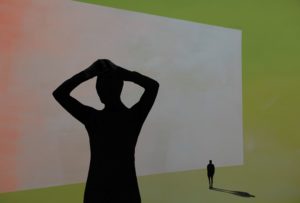Winnipeg: Winter 2019 - Vancouver Ballet Society
- Home
- City Reports 2015 - 2019
- Winnipeg: Winter 2019

By Holly Harris
Winnipeg’s Contemporary Dancers began its 55th season this fall by welcoming new artistic director Jolene Bailie. The Winnipeg-born-and-raised dance artist and graduate of the Professional Program of the School of Contemporary Dancers was appointed last February, following a nearly yearlong international search, with Bailie taking over from Brent Lott, who led the company between 2005 and 2017.

Photo: Gary Sewell
The 42-year-old, who has a master of fine art in dance through the American Dance Festival/Hollins University, is no stranger to the local dance community. She is the founding artistic director of 19-year-old Gearshifting Performance Works, through which she presented 39 of her original contemporary works, including 10 full-length shows. Her eclectic choreography has ranged from more surrealistic offerings such as All You Can Eat/The Top? (2014) and last year’s Schemas, 1-5 to visually arresting works such as Hybrid Human (2010), created in conjunction with Canadian visual artist Wanda Koop and premiered at the Winnipeg Art Gallery to critical acclaim. Her works have also been staged across Canada and internationally, including in New York, Beijing, Xi’an and Stuttgart.
Gearshifting Performance Works will now go “fallow” as Bailie turns her attention to getting Winnipeg’s Contemporary Dancers back on its feet, offering her inaugural, three-production season this year. The first show was an emerging dancer initiative in October at the Rachel Browne Theatre, featuring her own choreography performed by six local, multi-generational dance artists, with the 2019-2020 season’s total of 24 featured dancers hired on a per-project basis, which Bailie says allows choreographers to have a voice in selecting individual artists for their works. A second mixed bill opens on November 29 with new works by Winnipeg’s Zorya Arrow, Ming Hon and others. Next up is a touring production of Animal Triste in February by Montreal’s Mayday Dance with choreography by Mélanie Demers.
Bailie met Demers in the late 1990s while training at O Vertigo’s summer school. “As a dancer, I had wanted to work with Mélanie for the longest time, but then my world changed as I began to focus primarily on choreography. I’ve been following her work for many years and am thrilled to bring her to Winnipeg,” she says.
Some of her long-term goals include developing new touring opportunities as well as spotlighting the work of both mid-career and emerging choreographers and performers.
“I believe a clear investment in our mid-career artists by providing opportunities will ensure that we will have senior artists, that is part of my artistic vision and has actually been WCD’s mandate for a long time,” Bailie states. “I’ve always personally been interested in creating for dancers of all different backgrounds and experiences, as it brings a very different kind of richness to the work.”
On a more practical note, Bailie plans on offering professional daily class in tandem with each production’s creative process, open to each show’s ensemble of dancers and to members of the local community.
She clearly states she has no current plans to sell the company studios and the intimate Rachel Browne Theatre, located in the city’s historic Exchange District, in order to pay down a nagging deficit — a proposal by a local buyer that became a hotly debated point within the local dance community. Long term, Bailie hopes to create more training opportunities and collaborative projects with troupes from around the country.
Bailie speaks fondly of WCD founder Rachel Browne, the late contemporary dance matriarch with whom she worked extensively; she was in the original 1997 cast of Browne’s deeply personal Willow Island and performed her Kurt Weill-infused 1991 solo Freddy more than 30 times across Canada and the United States.
“Rachel was always curious about everything, which has been a valuable lesson to me,” she says. “She also had a clear vision, was very goal focused and worked hard, with a beautiful way of being patient and waiting until you got to where she wanted. She had a great calmness to her, but also paid a lot of attention to detail and was very wise. I do believe she loved us all, and loved all of the work we were doing in the community.”
She says running Gearshifting has helped prepare her for her newest role, which includes a multitude of responsibilities, not least of all creating annual budgets, preparing grant applications and reaching out to potential new audience members while growing the company’s subscriber base, in addition to teaching and new creation.
“I’ve learned to understand the difference between an individual artist’s goal and an organizational goal, because those are two very different things,” she explains. “As the leader of an organization, you want to not only create projects and opportunities that satisfy your personal artistic vision, but you also want to think about the dancers and the other artists who are involved in that project, and honour each individual for who they are.”
Bailie is also mining her experience as a teacher. “I have been teaching since I was a teenager and that experience has also affected how I envision an organization to run, because it’s all about working with people … You want to follow your artistic vision and create the work you want to create, but still provide meaningful opportunities for others, because the spirit of new creation also brings a deeper meaning to the artists involved, and to the audience.”
Life — and art — is a balance, and Bailie will continue to juggle both her professional and personal lives, including being a mother to three young children, with her ophthalmologist husband. She says that having children has only enriched her own artistic creation. “You begin to see life as being about not what is impossible, but what is possible.”

Photo: Hugh Conacher
